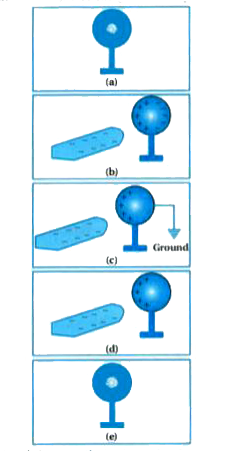Text Solution
Verified by Experts
Topper's Solved these Questions
ELECTRIC CHARGES AND FIELDS
KUMAR PRAKASHAN|Exercise SECTION B NUMERICALS (NUMERICAL FROM TEXTUAL EXERCISES)|24 VideosELECTRIC CHARGES AND FIELDS
KUMAR PRAKASHAN|Exercise SECTION B NUMERICALS (ADDITONAL EXERCISE)|10 VideosELECTRIC CHARGES AND FIELDS
KUMAR PRAKASHAN|Exercise SECTION A QUESTIONS- ANSWERS (TRY YOURSELF )|73 VideosDUAL NATURE OF RADIATION AND MATTER
KUMAR PRAKASHAN|Exercise Section-D (MCQs asked in GUJCET/Board Exam)|1 VideosELECTROMAGNETIC INDUCTION
KUMAR PRAKASHAN|Exercise Section D MCQs (MCQs asked in Competitive Exams )|38 Videos
Similar Questions
Explore conceptually related problems
KUMAR PRAKASHAN-ELECTRIC CHARGES AND FIELDS -SECTION B NUMERICALS (NUMERICAL FROM TEXTUAL ILLUSTRATIONS)
- How can you charge a metal sphere positively without touching it ?
Text Solution
|
- If 10^(9) electrons move out of a body to another body every second, h...
Text Solution
|
- How much positive and negative charge is there in a cup of water ?
Text Solution
|
- Coulomb's law for electrostatic force between two point charges and Ne...
Text Solution
|
- A charged metallic sphere A is suspended by a nylon thread. Another ch...
Text Solution
|
- Consider three charges q(1),q(2), q(3) each equal to q at the vertices...
Text Solution
|
- Consider the charges q, q and -q placed at vertices of an equilateral...
Text Solution
|
- An electron falls through a distance of 1.5cm in a uniform electric fi...
Text Solution
|
- Two point charges q(1) and q(2) of magnitude + 10^(-8) c and -10^(-8)...
Text Solution
|
- Tow charges pm10 mu C are placed 5.0 mm apart determine the electri...
Text Solution
|
- The electric field components are E(x)=ax^(-1//2),E(y)=E(z)=0 in whi...
Text Solution
|
- An electric field is uniform and in the positive x direction for posit...
Text Solution
|
- An early model for an atom considered it to have a positively charged ...
Text Solution
|
- How can a metallic sphere be charged negatively without touching it ?
Text Solution
|
- If 10^10 electrons move out of a body to another body every second, ho...
Text Solution
|
- How much positive and negative charge is there in a 100 g water ? (Mol...
Text Solution
|
- Charges on identical spheres A and B are equal. When the separation be...
Text Solution
|
- + q, + q, - q and - q are kept at vertices of square ABCD respectively...
Text Solution
|
- Four equal point charges of 16 muC are kept at vertices of square of ...
Text Solution
|
- An electron falls through a distance of 2 cm ir a uniform electric fie...
Text Solution
|
